Uniaxial Creep Test Analysis on Creep Characteristics of Fully Weathered Sandy Shale
Abstract
1. Introduction
2. Laboratory Experiments of Fully Weathered Sandy Shale
2.1. Experimental Material
2.2. Uniaxial Compressive Strength Test
2.3. Uniaxial Creep Characteristic Test
2.3.1. Test Equipment
2.3.2. Test Scheme
- (1)
- The value of moisture content
- (2)
- Step loading
3. Analysis of the Creep Test Results
3.1. Typical Rock Creep Curve
3.2. Creep Characteristic Test-Result Analysis
- (1)
- The specimen undergoes instantaneous elastic deformation as soon as the load is applied. With an increase in loading time, the creep undergoes the primary creep stage and the steady-state creep stage. At the end of loading, the creep deformation tends to be stable and has not yet entered into the accelerated creep stage;
- (2)
- The instantaneous elastic deformation of the specimen increases with an increase in moisture content. For instance, under a load of 38.2 kPa, the instantaneous elastic deformation was 0.102 mm with a moisture content of 15.8%, while the instantaneous elastic deformation was 0.321 mm with a moisture content of 29.18%. The instantaneous elastic deformation increased by 68% when the moisture content increased by 45%. The reason for this is that the increase in moisture content weakens the cementation force and the friction force between the soil particles and results in the increasing deformation of the specimen;
- (3)
- The ratio of creep deformation to total deformation increases with any increase in moisture content. For instance, under a load of 38.2 kPa, the deformation of the specimen with a moisture content of 15.8% accounted for 59% of the total deformation, while the deformation of the specimen with a moisture content of 29.18% accounted for 71%. This shows that the higher the moisture content, the greater the influence of the creep deformation on the total deformation of fully weathered sandy shale, which needs great attention in engineering;
- (4)
- The test results show that the higher the moisture content and the higher the load level, the longer the initial creep duration of the specimen. For instance, when the moisture content was 15.8%, the duration of the initial creep was 90 min under the load of 38.2 kPa, while the duration of the initial creep was 130 min under the load of 57.3 kPa. When the moisture content was 29.18%, the duration of the initial creep was 120 min under the load of 38.2 kPa, while the duration of the initial creep was 190 min under the load of 57.3 kPa. In other words, when the moisture content increased from 15.8% to 29.18% under the load of 38.2 kPa, the duration of the initial creep increased by 25%. When the load level increased from 38.2 kPa to 57.3 kPa, the duration of the initial creep increased by 31%, with a moisture content of 15.8%. The main reason for this is that the existence of water makes the internal pores of the specimen interpenetrate. A specimen with higher moisture content needs more time to adjust and reorganize the initial particles to reach a steady state;
- (5)
- Creep deformation increases with any increase in load level or moisture content, and the influence of moisture content is more significant. For instance, when the moisture content was 15.8%, the creep deformation was 0.148 mm under a load of 38.2 kPa and 0.226 mm under a load of 76.4 kPa. That is, the creep deformation increased by 35% when the load increased by 50% under the same moisture content. Under a load of 38.2 kPa, the creep deformation was 0.148 mm when the moisture content of the specimen was 15.8% and 0.800 mm when the moisture content of the specimen was 29.18%. That is, the creep deformation increased by 82% when the moisture content increased by 45% under the same load level;
- (6)
- The steady creep deformation rate increases with any increase in moisture content or load level, and the influence of moisture content is more significant. For instance, when the moisture content was 15.8%, the steady creep deformation rate was 1.06 × 10−3 mm/h under a load of 38.2 kPa and 1.68 × 10−3 mm/h under a load of 76.4 kPa. That is, the steady creep deformation rate increased by 37% when the load increased by 50% under the same moisture content. Under a load of 38.2 kPa, the steady creep deformation rate was 1.06 × 10−3 mm/h when the moisture content of the specimen was 15.8% and 8.72 × 10−3 mm/h when the moisture content of the specimen was 29.18%. That is, the steady creep deformation rate increased by 88% when the moisture content increased by 45% under the same load level. The steady creep deformation rate of the specimen with low moisture content was close to zero, and the creep deformation no longer increased. Therefore, reducing moisture content is beneficial in controlling creep deformation and ensuring stability of rock.
4. Creep Model of Fully Weathered Sandy Shale, Considering the Moisture Content
4.1. Creep Model of Fully Weathered Sandy Shale
- (1)
- Instantaneous deformation occurs at the moment of loading and the deformation of the specimen can be partially recovered after unloading, so there must be elastic elements in the creep model.
- (2)
- There is a nonlinear relationship between deformation and time. The deformation of the specimen increases with an extension of loading time.
- (3)
- The uniaxial compressive strength of the specimen was low and the integrity was poor. The creep phenomenon appeared at a relatively low stress level.
4.2. Analysis of Creep Model Parameters
- (1)
- Effects of moisture content on creep model parameters
- (2)
- Effects of load level on creep model parameters
4.3. Establishment of the Creep Equations Considering the Moisture Content
4.4. Discussion of the Creep Equations Considering the Moisture Content
5. Conclusions
- (1)
- Fully weathered sandy shale is easy to disintegrate in water, and its strength is high in the dry state. With an increase in moisture content, the compressive strength of the specimen decreases significantly. The compressive strength of the specimen with a moisture content of 29.18% was only 18% of the specimen in the dry state.
- (2)
- The creep characteristic curves of fully weathered sandy shale under the load of 20~60% of the ultimate strength had only two creep stages, the primary creep stage and the steady-state creep stage, with no accelerated creep stage. The creep deformation increased with time nonlinearly.
- (3)
- The creep behavior of fully weathered sandy shale is obviously affected by moisture content and load level. The greater the moisture content, the higher the load level, resulting in larger instantaneous elastic deformation, a larger steady creep rate and greater creep deformation. The duration of initial creep is longer as well. Moisture content has a more significant influence on creep behavior than does load level. In the later part of the steady-state creep stage, the creep rate of specimens with low moisture content was close to zero, the creep deformation no longer increased and the specimens entered a stable state. Therefore, it is quite beneficial to reduce moisture content in order to control creep deformation.
- (4)
- The elastic coefficients E1/E2 and viscosity coefficients η1/η2 are correlated with moisture content and load level. E1/E2/η1/η2 decrease with an increase in moisture content; E1 decreases with an increase in load level while E2/η1/η2 increase with an increase in load level.
- (5)
- The creep model of fully weathered sandy shale, considering moisture content, fits well with the creep experiment. It is expected to provide a theoretical basis for the large deformation mechanism and disaster treatment of fully weathered sandy shale.
Author Contributions
Funding
Institutional Review Board Statement
Informed Consent Statement
Data Availability Statement
Conflicts of Interest
References
- Zhou, X.; Pan, X.; Berto, F. A state-of-the-art review on creep damage mechanics of rocks. Fatigue Fract. Eng. Mater. Struct. 2022, 45, 627–652. [Google Scholar] [CrossRef]
- Yang, C.; Daemen, J.; Yin, J. Experimental investigation of creep behavior of salt rock. Int. J. Rock Mech. Min. Sci. 1999, 2, 233–242. [Google Scholar] [CrossRef]
- Yang, S.; Jiang, Y. Triaxial mechanical creep behavior of sandstone. Min. Sci. Technol. 2010, 3, 339–349. [Google Scholar] [CrossRef]
- Xie, S.; Shao, J.; Xu, W. Influences of chemical degradation on mechanical behavior of a limestone. Int. J. Rock Mech. Min. Sci. 2011, 5, 741–747. [Google Scholar] [CrossRef]
- Yang, S.; Jing, H.; Cheng, L. Influences of pore pressure on short-term and creep mechanical behavior of red sandstone. Eng. Geol. 2014, 179, 10–23. [Google Scholar] [CrossRef]
- Sun, X.; Miao, C.; Jiang, M.; Zhang, Y.; Yang, L.; Guo, B. Experimental and theoretical study on creep behaviors of sandstone with different moisture contents based on modified Nishihara model. Chin. J. Rock Mech. Eng. 2021, 40, 2411–2420. [Google Scholar]
- Zhu, H.; Ye, B. Experiment study on creep mechanical properties of tunnel surrounding rock under saturated state. Chin. J. Rock Mech. Eng. 2002, 21, 1791–1796. [Google Scholar]
- Chen, Q.; Nishida, K.; Iwamoto, T.; Kameya, H.; Itabasi, T. Creep behavior of sedimentary soft rock under triaxial compression. Chin. J. Rock Mech. Eng. 2003, 22, 905–912. [Google Scholar]
- Maranini, E.; Brignoli, M. Creep behavior of a weak rock: Experimental characterization. Int. J. Rock Mech. Min. 1999, 36, 127–138. [Google Scholar] [CrossRef]
- Zohravi, S.E.; Lakirouhani, A.; Molladavoodi, H.; Medzvieckas, J.; Kliukas, R. A new constitutive model for the time-dependent behavior of rocks with consideration of damage parameter. J. Civ. Eng. Manag. 2022, 28, 223–231. [Google Scholar] [CrossRef]
- Zhu, X.; Yang, S.; Xia, H.; Xia, Q.; Zhang, G. Joint support technology and its engineering application to deep soft rock tunnel with strong creep. Geotech. Geol. Eng. 2020, 38, 3403–3414. [Google Scholar] [CrossRef]
- Wang, Y.; Liu, Y.; Wang, Z.; Zhang, X.; Hui, Y.; Li, J. Investigation on progressive failure progress of tunnel lining induced by creep effect of surrounding rock: A case study. Eng. Fail. Anal. 2023, 144, 106946. [Google Scholar] [CrossRef]
- Li, W.; Han, Y.; Wang, T.; Ma, J. DEM micromechanical modeling and laboratory experiment on creep behavior of salt rock. J. Nat. Gas Sci. Eng. 2017, 46, 38–46. [Google Scholar] [CrossRef]
- Okubo, S.; Nishimatsu, Y.; Fukui, K. Complete creep curves under uniaxial compression. Int. J. Rock Min. Sci. Geomech. Abstr. 1991, 28, 77–82. [Google Scholar] [CrossRef]
- Wang, X.; Huang, Q.; Lian, B.; Liu, N.; Zhang, J. Modified Nishihara rheological model considering the effect of thermal-mechanical coupling and its experimental verification. Adv. Mater. Sci. Eng. 2018, 2018, 4947561. [Google Scholar] [CrossRef]
- Gutierrez-Ch, J.; Senent, S.; Graterol, E.; Zeng, P.; Jimenez, R. Rock shear creep modelling: DEM-Rate process theory approach. Int. J. Rock Mech. Min. 2023, 161, 105295. [Google Scholar] [CrossRef]
- Zhang, X.; Wei, C.; Zhang, H. Analysis of Surrounding Rock Creep Effect on the Long-Term Stability of Tunnel Secondary Lining. Shock Vib. 2021, 2021, 4614265. [Google Scholar] [CrossRef]
- Ministry of Transport of the people’s Republic of China. Industrial Standard of China (JTG E41-2005): Rock Test Procedures for Highway Engineering; China communication Press: Beijing, China, 2005; pp. 27–47. ISBN 9787114133510. [Google Scholar]
- Griggs, D. Creep of Rocks. J. Geol. 1939, 47, 225–251. [Google Scholar] [CrossRef]
- Yang, Z.; Jin, A.; Zhou, Y.; Yan, Q.; Wang, K.; Gao, Y. Parametric analysis of Burgers model and creep properties of rock with particle flow code. Rock Soil Mech. 2015, 36, 240–248. [Google Scholar]

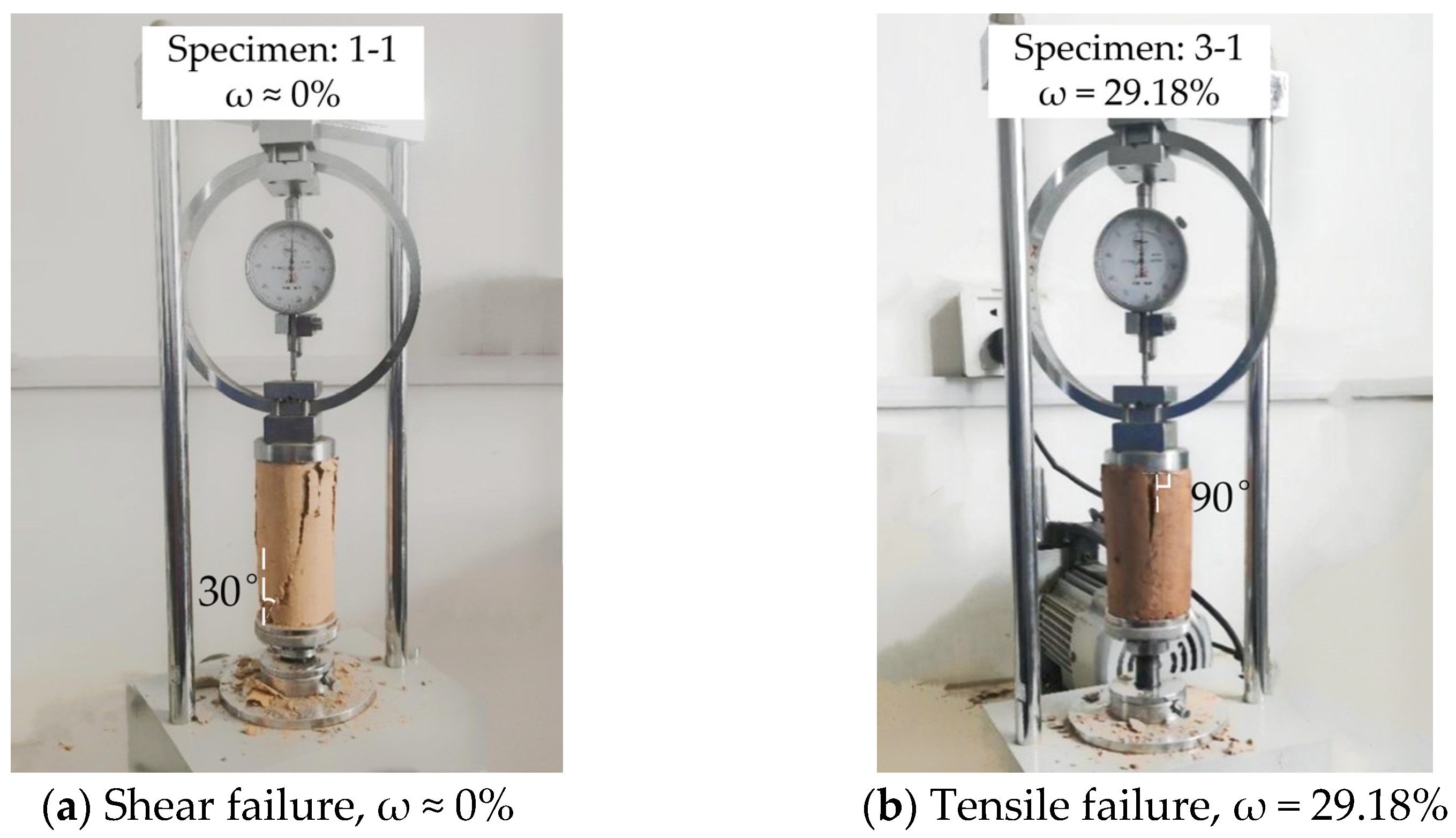
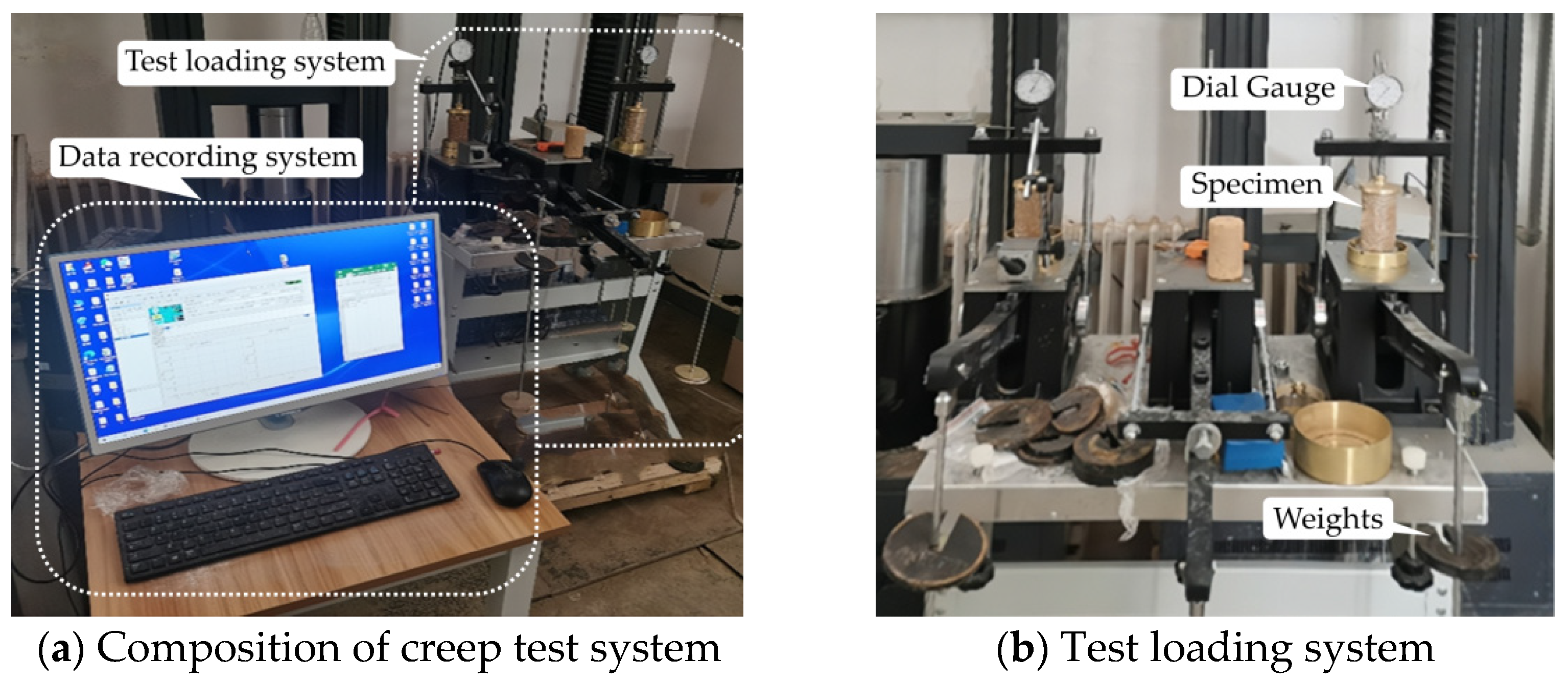
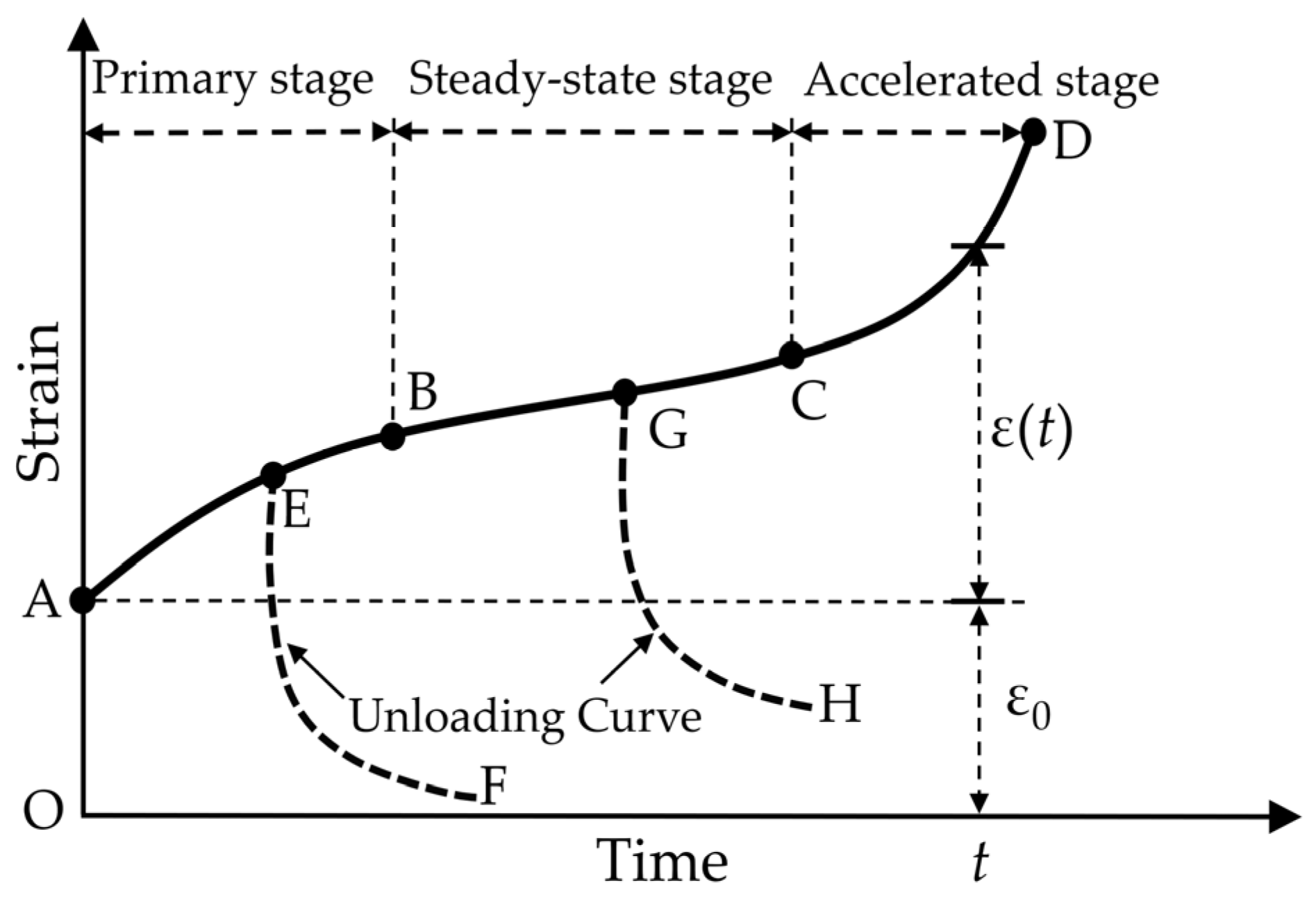


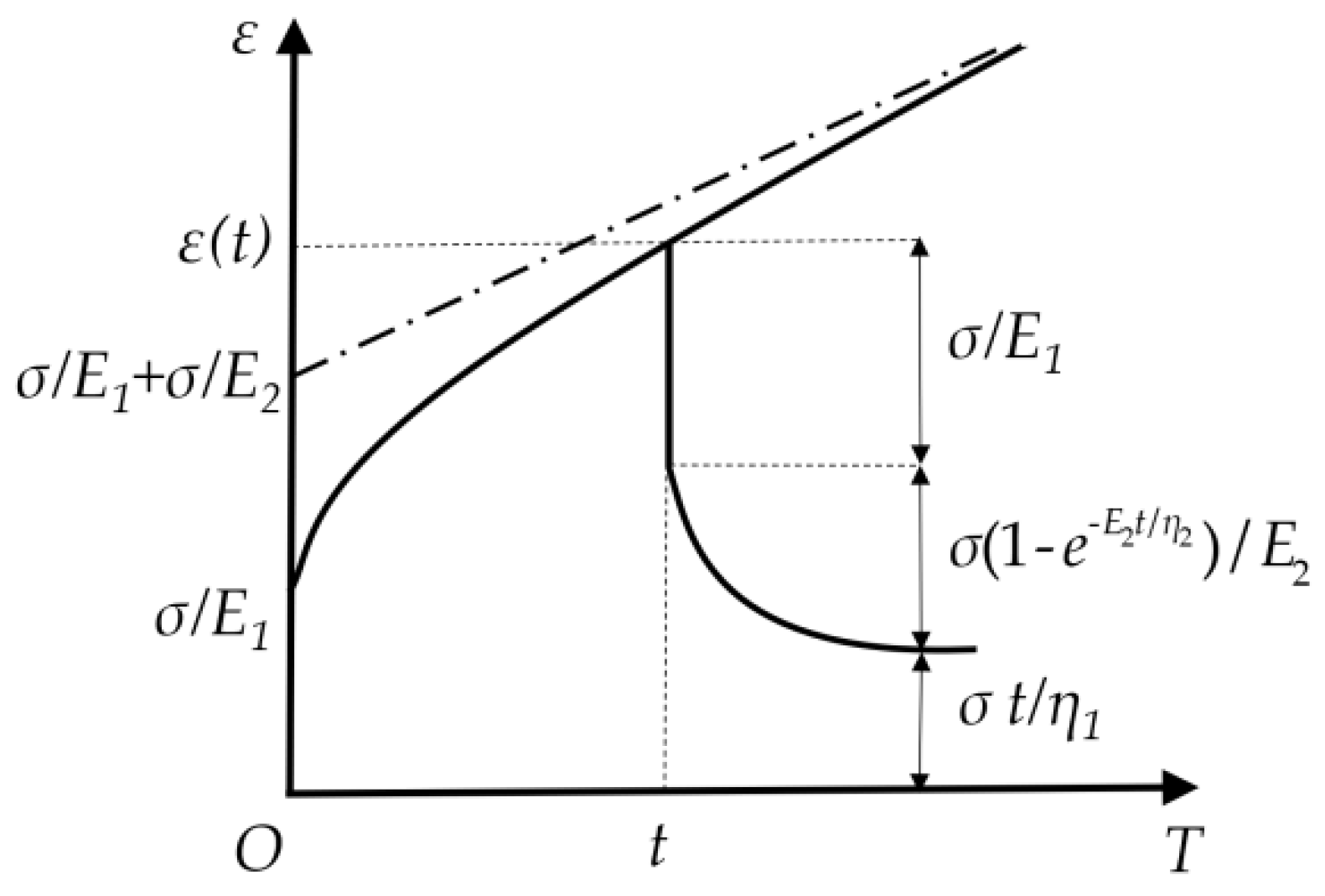
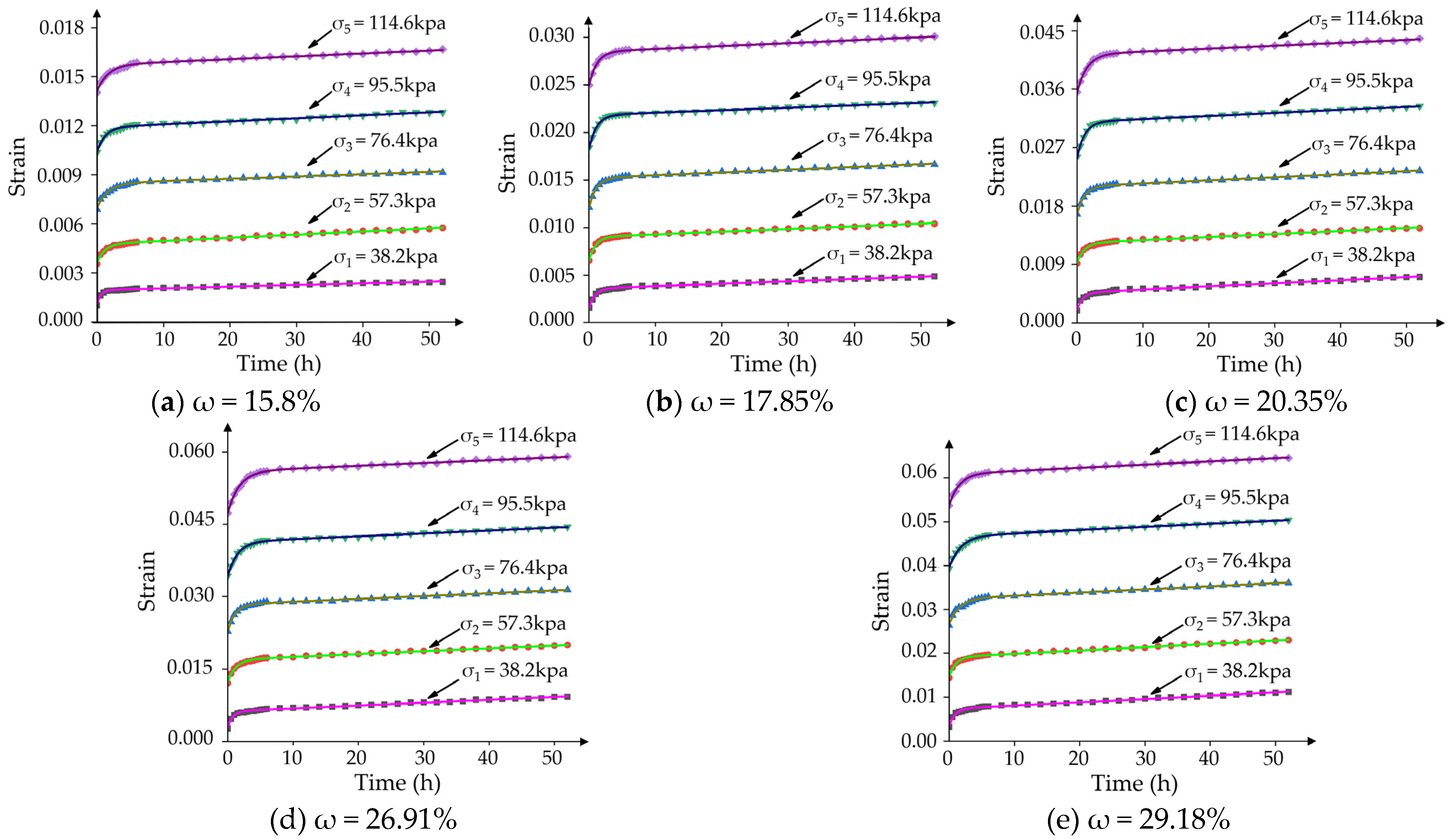
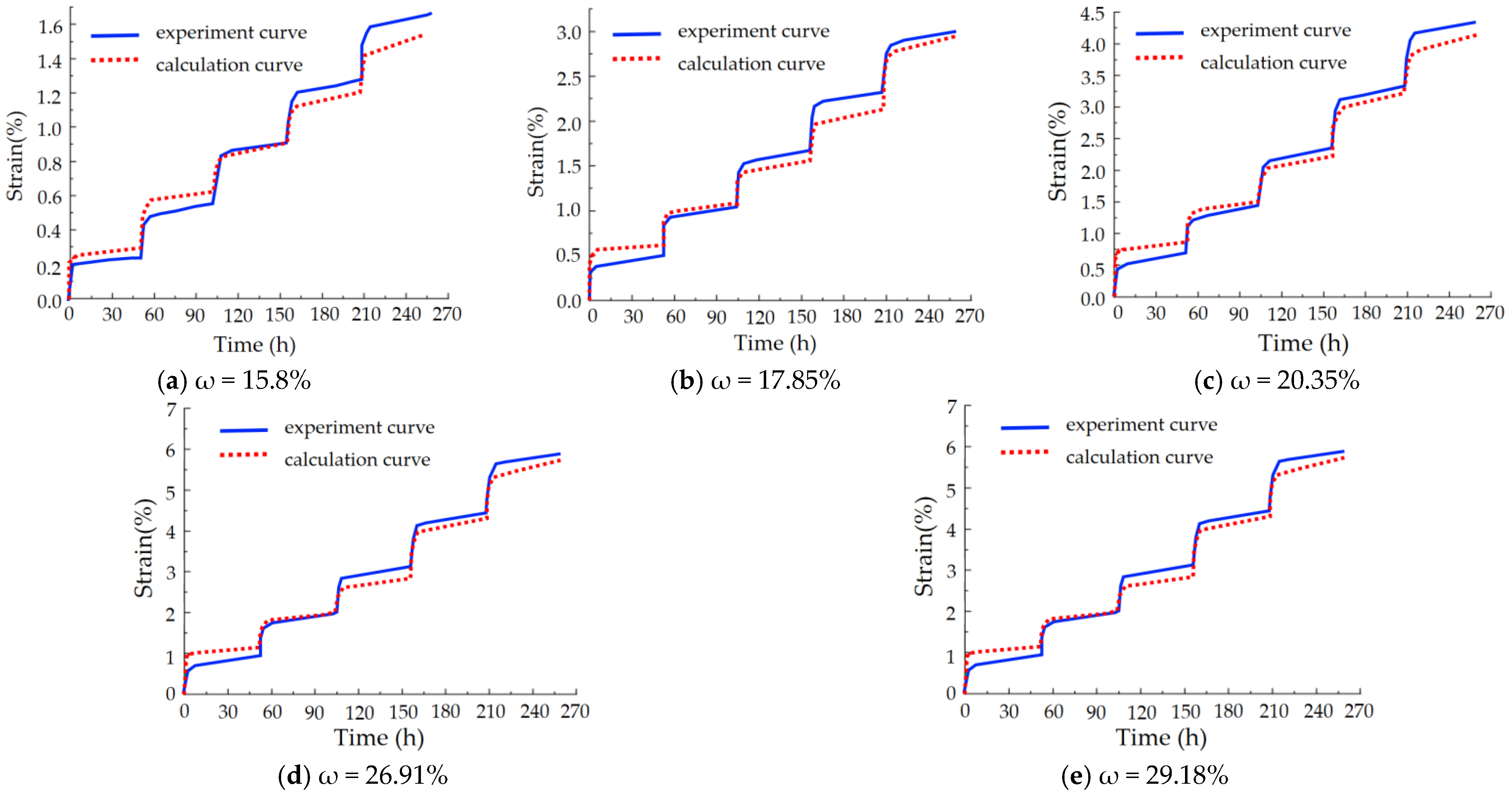
| Specimen Number | Moisture Content ω | Average Compressive Strength |
|---|---|---|
| 1–1; 1–2 | Close to 0% | 1068.8 kPa |
| 2–1; 2–2 | 20.35% | 320.2 kPa |
| 3–1; 3–2 | 29.18% | 191.0 kPa |
| Moisture Content | Pressure (kPa) | Instantaneous Elastic Deformation (mm) | Steady Creep Deformation Rate (mm/h) | Creep Deformation (mm) |
|---|---|---|---|---|
| 15.80% | 38.2 | 0.102 | 1.06 × 10−3 | 0.148 |
| 57.3 | 0.105 | 1.62 × 10−3 | 0.206 | |
| 76.4 | 0.109 | 1.68 × 10−3 | 0.226 | |
| 95.5 | 0.110 | 1.72 × 10−3 | 0.257 | |
| 114.6 | 0.114 | 2.27 × 10−3 | 0.271 | |
| 17.85% | 38.2 | 0.159 | 2.96 × 10−3 | 0.333 |
| 57.3 | 0.161 | 3.10 × 10−3 | 0.396 | |
| 76.4 | 0.163 | 3.23 × 10−3 | 0.464 | |
| 95.5 | 0.164 | 3.42 × 10−3 | 0.491 | |
| 114.6 | 0.169 | 3.60 × 10−3 | 0.514 | |
| 20.35% | 38.2 | 0.194 | 4.75 × 10−3 | 0.524 |
| 57.3 | 0.197 | 4.93 × 10−3 | 0.560 | |
| 76.4 | 0.199 | 5.16 × 10−3 | 0.681 | |
| 95.5 | 0.202 | 5.37 × 10−3 | 0.793 | |
| 114.6 | 0.204 | 5.50 × 10−3 | 0.825 | |
| 26.91% | 38.2 | 0.270 | 6.54 × 10−3 | 0.659 |
| 57.3 | 0.276 | 7.03 × 10−3 | 0.731 | |
| 76.4 | 0.277 | 7.15 × 10−3 | 0.867 | |
| 95.5 | 0.280 | 7.70 × 10−3 | 1.018 | |
| 114.6 | 0.284 | 8.16 × 10−3 | 1.176 | |
| 29.18% | 38.2 | 0.321 | 8.72 × 10−3 | 0.800 |
| 57.3 | 0.324 | 8.84 × 10−3 | 0.861 | |
| 76.4 | 0.328 | 9.05 × 10−3 | 0.974 | |
| 95.5 | 0.331 | 9.26 × 10−3 | 1.130 | |
| 114.6 | 0.410 | 9.38 × 10−3 | 1.204 |
| Moisture Content | σ (kPa) | E1 (kPa) | E2 (kPa) | η1 (kPa·h) | η2 (kPa·h) |
|---|---|---|---|---|---|
| 15.80% | 38.2 | 37,106 | 41,455 | 2,666,666 | 22,238 |
| 57.3 | 15,896 | 49,291 | 3,980,900 | 55,653 | |
| 76.4 | 10,919 | 51,881 | 5,471,200 | 86,896 | |
| 95.5 | 9172 | 64,157 | 5,221,700 | 81,234 | |
| 114.6 | 8108 | 72,362 | 6,543,700 | 122,970 | |
| Mean value | 16,240 | 55,829 | 4,776,833 | 73,798 | |
| 17.85% | 38.2 | 23,810 | 19,168 | 1,530,400 | 17,731 |
| 57.3 | 8750 | 23,478 | 2,003,300 | 22,565 | |
| 76.4 | 6293 | 24,956 | 2,598,800 | 27,251 | |
| 95.5 | 5212 | 27,216 | 3,687,100 | 30,471 | |
| 114.6 | 4583 | 32,970 | 3,701,700 | 38,354 | |
| Mean value | 9730 | 25,558 | 2,704,260 | 27,274 | |
| 20.35% | 38.2 | 18,192 | 14,482 | 823,410 | 13,901 |
| 57.3 | 6186 | 19,001 | 1,228,400 | 20,719 | |
| 76.4 | 4567 | 17,786 | 1,616,000 | 19,692 | |
| 95.5 | 3752 | 17,398 | 2,013,500 | 19,494 | |
| 114.6 | 3232 | 19,499 | 2,577,100 | 28,702 | |
| Mean value | 7186 | 17,633 | 1,651,682 | 20,502 | |
| 26.91% | 38.2 | 13,574 | 11,111 | 649,260 | 8539 |
| 57.3 | 4679 | 13,351 | 960,070 | 14,895 | |
| 76.4 | 3352 | 14,613 | 1,315,200 | 16,697 | |
| 95.5 | 2789 | 14,106 | 1,605,700 | 20,206 | |
| 114.6 | 2423 | 15,875 | 1,939,400 | 23,450 | |
| Mean value | 5363 | 13,811 | 1,293,926 | 16,757 | |
| 29.18% | 38.2 | 11,399 | 9705 | 493,800 | 7795 |
| 57.3 | 3912 | 12,192 | 756,310 | 12,868 | |
| 76.4 | 2860 | 13,188 | 1,068,500 | 18,258 | |
| 95.5 | 2412 | 13,430 | 1,346,500 | 17,284 | |
| 114.6 | 2130 | 13,152 | 1,580,900 | 20,684 | |
| Mean value | 4543 | 12,314 | 1,049,202 | 15,378 |
Disclaimer/Publisher’s Note: The statements, opinions and data contained in all publications are solely those of the individual author(s) and contributor(s) and not of MDPI and/or the editor(s). MDPI and/or the editor(s) disclaim responsibility for any injury to people or property resulting from any ideas, methods, instructions or products referred to in the content. |
© 2023 by the authors. Licensee MDPI, Basel, Switzerland. This article is an open access article distributed under the terms and conditions of the Creative Commons Attribution (CC BY) license (https://creativecommons.org/licenses/by/4.0/).
Share and Cite
Zhang, L.; Huang, C.; Li, Z.; Han, Z.; Weng, X.; Wang, L. Uniaxial Creep Test Analysis on Creep Characteristics of Fully Weathered Sandy Shale. Processes 2023, 11, 610. https://doi.org/10.3390/pr11020610
Zhang L, Huang C, Li Z, Han Z, Weng X, Wang L. Uniaxial Creep Test Analysis on Creep Characteristics of Fully Weathered Sandy Shale. Processes. 2023; 11(2):610. https://doi.org/10.3390/pr11020610
Chicago/Turabian StyleZhang, Lianzhen, Changxin Huang, Zhipeng Li, Zichuan Han, Xianjie Weng, and Lige Wang. 2023. "Uniaxial Creep Test Analysis on Creep Characteristics of Fully Weathered Sandy Shale" Processes 11, no. 2: 610. https://doi.org/10.3390/pr11020610
APA StyleZhang, L., Huang, C., Li, Z., Han, Z., Weng, X., & Wang, L. (2023). Uniaxial Creep Test Analysis on Creep Characteristics of Fully Weathered Sandy Shale. Processes, 11(2), 610. https://doi.org/10.3390/pr11020610







